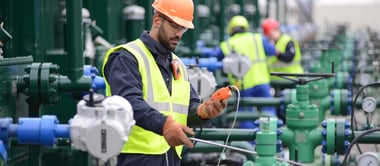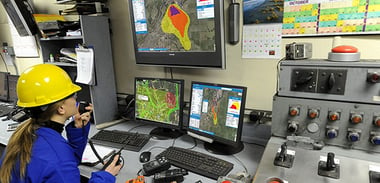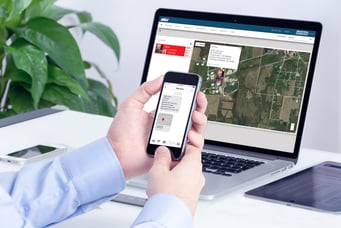 Lone workers are individuals who perform their duties in isolation, often in remote or hazardous environments. The inherent risks they face, including gas exposure, severe weather conditions, and potential injuries, make it critical for organizations to implement real-time monitoring and proactive safety solutions. These workers, such as field technicians, oil and gas employees, and contractors, require comprehensive safety measures to ensure their wellbeing and quick emergency response.
Lone workers are individuals who perform their duties in isolation, often in remote or hazardous environments. The inherent risks they face, including gas exposure, severe weather conditions, and potential injuries, make it critical for organizations to implement real-time monitoring and proactive safety solutions. These workers, such as field technicians, oil and gas employees, and contractors, require comprehensive safety measures to ensure their wellbeing and quick emergency response.
Challenges of Protecting Lone Workers
Working in Isolation: Lone workers encounter unique dangers that can escalate quickly if not addressed promptly. For instance, a worker might encounter a gas leak without immediate backup, leading to severe consequences. The isolation increases the risk, as help might be delayed by hours or even days. Hazardous conditions, such as gas exposure, severe weather, and physical injuries, can turn fatal without timely intervention.
Limitations of Manual Check-ins: Many companies rely on manual check-ins as part of their lone worker policies, where workers contact safety managers at regular intervals. However, this method has significant drawbacks. Missed or delayed check-ins can lead to tragedies, and the process can be time-consuming, reducing overall productivity. Workers may miss check-ins due to various reasons, and safety personnel are left uncertain whether to treat the situation as an emergency or a false alarm.
Connectivity Challenges in Remote Locations: Lone workers often operate in areas with limited or no cellular service, making it challenging to call for help. In some regions, the use of personal cell phones is prohibited on site, further complicating communication. These connectivity issues can leave lone workers without a reliable lifeline in critical situations.
Key Features of a Modern Lone Worker Monitoring System
A modern lone worker monitoring system should offer integrated solutions that include GPS tracking, panic buttons, man-down alarms, and gas detection. These features simplify monitoring, reduce the number of devices workers need to carry, and minimize the risk of missed alerts. Combining all essential safety tools in one device ensures comprehensive protection for lone workers.
To ensure continuous coverage, lone worker monitoring systems must have automatic failover connectivity. This feature allows devices to switch between cellular and satellite networks seamlessly, maintaining uninterrupted data transmission. For example, the TGX Gateway provides reliable connectivity by automatically switching from cell to satellite coverage, ensuring that safety information is always transmitted.
Real-time monitoring and instant alerts are crucial for the safety of lone workers. Monitoring systems should send alerts via SMS or email to safety teams, including essential details such as the worker's name, location, and the reason for the alarm. This immediate communication enables quick emergency responses and prevents situations from escalating.
Optimizing Lone Worker Safety with Live Monitoring Tools
Automated Check-ins for Continuous Monitoring: Automated check-ins eliminate the need for manual status updates, providing continuous real-time monitoring of lone workers. This feature ensures compliance with OSHA’s requirements to account for workers regularly and enhances overall safety by maintaining constant visibility of worker status.
Using Data to Improve Response Times: Real-time data, such as gas readings and panic alarms, can trigger immediate emergency responses. For instance, monitoring a worker exposed to carbon monoxide (CO) gas at a remote location allows safety personnel to dispatch help instantly. This proactive approach significantly improves response times and can save lives.
Seamless Connectivity Across Devices: Lone worker monitoring systems should automatically sync with cloud platforms, ensuring seamless connectivity without the need for manual troubleshooting. Devices should connect as soon as they are powered on, providing reliable and continuous safety monitoring.
An Example of Lone Worker Safety in Action
Jim, a lone worker, encounters hazardous gas while working remotely and suffers a severe knee injury. Unable to move quickly, he is in a dangerous situation without immediate backup.
However, Jim's GPS-enabled gas monitor sends real-time alerts via satellite to safety personnel, providing his exact location and status. Thanks to the monitoring system, help is dispatched instantly, preventing the situation from escalating and ensuring Jim's safety.
Best Practices for Implementing a Lone Worker Monitoring System
 Select integrated systems like the Ventis® Pro5 Multi-Gas Monitor paired with the TGX Gateway. These devices combine all critical safety tools into one package, ensuring comprehensive protection for lone workers.
Select integrated systems like the Ventis® Pro5 Multi-Gas Monitor paired with the TGX Gateway. These devices combine all critical safety tools into one package, ensuring comprehensive protection for lone workers.
Establish clear escalation plans for emergencies, detailing who gets notified and when. Use live monitoring systems to prevent delays in emergency responses, ensuring that help arrives as quickly as possible.
Ensure that workers are well-trained in using GPS tracking, man-down alarms, and panic buttons. Conduct regular drills to prepare for emergencies, ensuring that workers know how to respond effectively.
Why Every Company Needs a Lone Worker Monitoring System
Implementing a lone worker monitoring system reduces risks by providing continuous visibility and fast response times. Companies must prioritize connected safety solutions to protect their lone workers, ensuring their safety and security in all situations.
Explore solutions like the TGX Gateway and Ventis® Pro5 Multi-Gas Monitor to keep your lone workers safe and provide peace of mind for both employees and employers.



